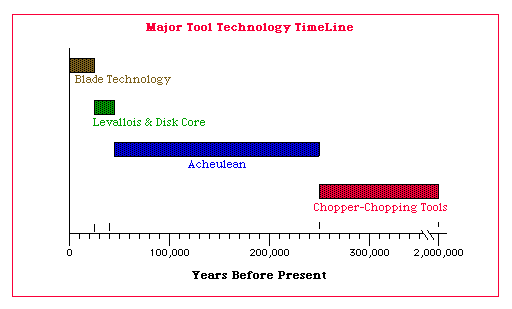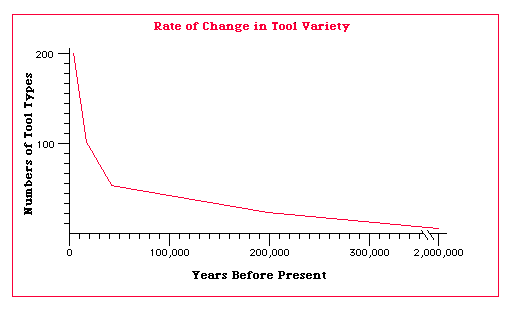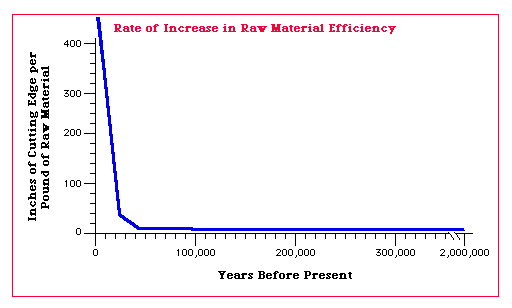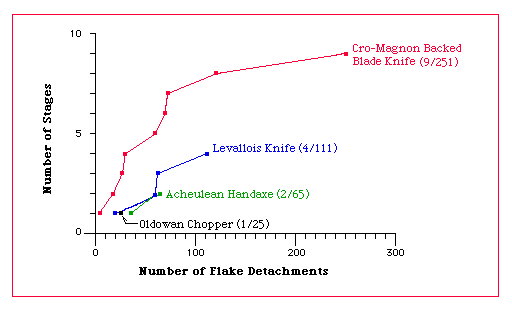Lithic Technology 10 - Summing It All Up
Over the course of the past several exercises, starting with the
exploration of Olduvai Gorge and ending here, you have been introduced to major
developments in stone tool manufacturing and use. This section will briefly sum
the major points made.
- First, stone tool making and use can be demonstrated to have an
extreme antiquity, dating to at least 1.75 million years ago. It may be that
hominids were using stone tools earlier, but beyond a certain point it is
extremely difficult to distinguish intentional usewear from naturally occurring
wear, especially given the time depth involved.
- Second, the basic techniques of stone tool manufacturing, hammer and
anvil, bipolar, and hard and soft hammer flaking; also have great antiquity.
Only pressure flaking appears to develop later, but became quite common during
the Middle Paleolithic and is in evidence on a wide variety of preshaped flake
tools. Thus, the history of lithic technology is marked by changes in the way
in which these techniques were applied rather than by marked changes in the
basic techniques. After all, there are only so many ways to break a rock to
make a sharp edge! The real changes occurred in the strategies for combining
these techniques into increasingly efficient methods for manufacturing useful
implements.

- Third, through time the variety of stone tool forms increases dramatically.
As we saw at Olduvai, the earliest industries consisted of only a few basic
types of tools dominated by choppers, and supplemented with a variety of
expediency tools such as sharp flakes that were likely the by-product of chopper
manufacture. As we progress through time to the Early Acheulean the variety of
tool types increases slightly. In the Middle Paleolithic, the variety of tool
types is staggering. This period is typified by more highly refined tools
manufactured for very specific purposes. The Upper Paleolithic continues the
trend with very task-specific tools being manufactured on highly standardized
blanks - blades.

- Fourth, there is a trend through time for producing more cutting edge per
unit of raw material. In the Chopper-Chopping Tool and Acheulean Industries,
one core tool and perhaps a few usable flakes could be manufactured from a
single pound of raw material. In the case of the Acheulean Handaxes, the result
was a very useful multipurpose tool that would last for quite awhile, but which
would eventually wear out after a few resharpenings, and which only had a few
inches of usable cutting edge.
In the Middle Paleolithic, with the
adoption of the Levallois and especially the Disk Core Techniques, core tools
were largely replaced by flake tools made from preshaped cores. About ten times
as much usable cutting edge could be produced from the same amount of material
used to make an Acheulean Handaxe. The trend culminated in the Upper
Paleolithic with the development of Blade Technology. Using this technique,
roughly 100 times the amount of useful cutting edge could be produced from the
same quantity of raw material.

- Fifth, the increasing refinement of stone tools was accompanied by
increases in the complexity of the process of manufacturing them and in the
investment of time and energy that each tool represented. For example, a usable
Acheulean Handaxe could be made with 25 well placed blows in one step. That
process would probably take only a few minutes. An Upper Paleolithic blade
knife would take up to 251 flake removals in nine fairly complex steps!
While raw material was being used more efficiently, the tools were taking longer
to manufacture because of the necessary additional steps required to use the
material more efficiently. Part of this process also involved a change in the
role that the stone tool played. Where initially the stone tool was the tool,
in the Middle and Upper Paleolithic the stone tool was becoming just a part of a
more complex compound tool adapted to a very specific task. A compound tool
such as a hunting spear would have a stone point attached to a hardwood
foreshaft, that was in turn socketed into a main shaft, that was in turn hooked
with an atl-atl or throwing stick.

![[Prev Page]](../../images/Btns/PrevBtn.gif)
|
|
![[Next Page]](../../images/Btns/NextBtn.gif)
|
|
|



